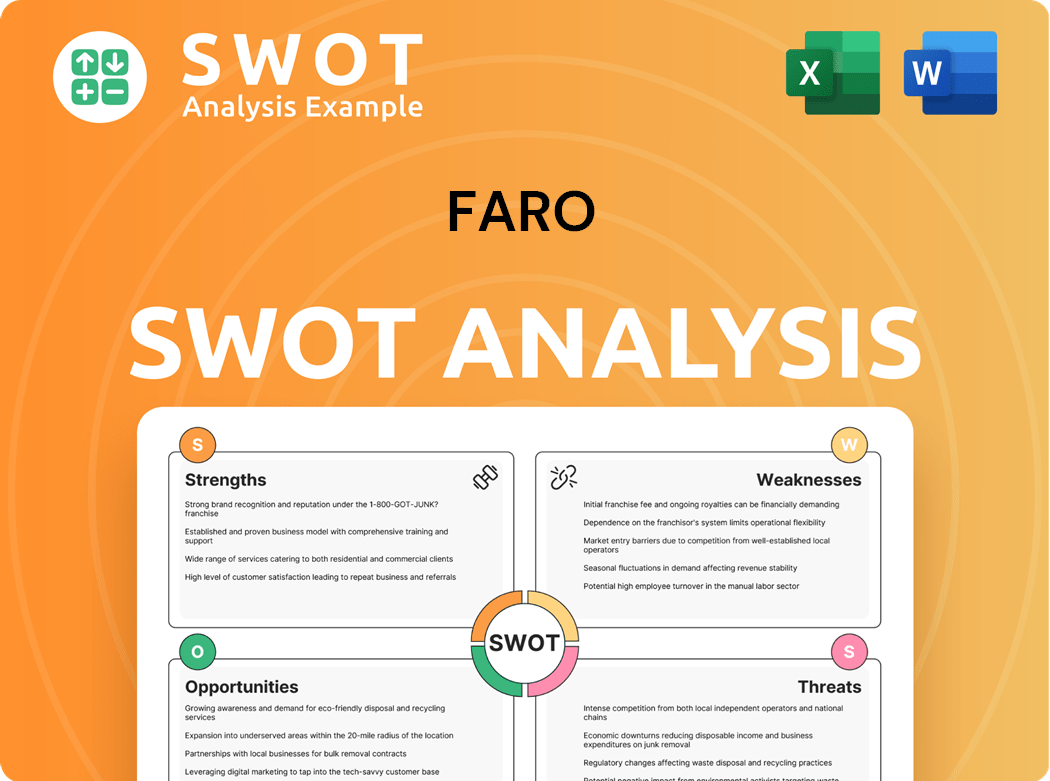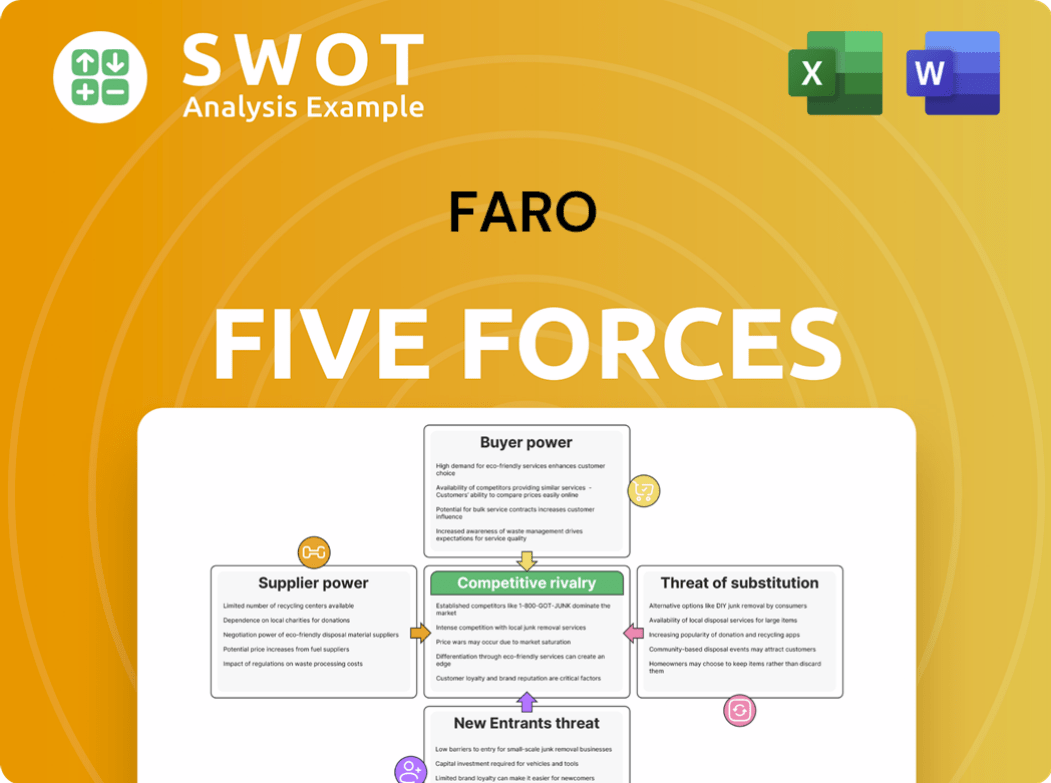FARO Bundle
How Does FARO Company Thrive in the 4D Digital Reality Realm?
FARO Technologies, Inc. (Nasdaq: FARO) is at the forefront of 4D digital reality solutions, transforming how industries interact with the physical world. With Q1 2025 revenue hitting $82.9 million, FARO demonstrates its robust performance and strategic prowess. Its innovative computer-aided measurement and imaging devices and software are essential tools across manufacturing, construction, and public safety.

To fully grasp FARO's potential, it's vital to understand its operational dynamics and revenue models. This analysis delves into FARO SWOT Analysis, examining its FARO products, FARO technologies, and competitive advantages. We will explore how FARO company utilizes 3D measurement and 3D modeling to maintain its leadership, covering aspects like FARO's laser scanner applications, software capabilities, and global impact across various sectors, including the automotive industry and construction.
What Are the Key Operations Driving FARO’s Success?
FARO Technologies focuses on creating and delivering value through advanced 3D measurement, imaging, and realization solutions. Their core business revolves around providing a comprehensive suite of hardware and software designed for precision applications. This includes a range of FARO products like the FaroArm Portfolio, FARO Laser Tracker, and FARO Laser Scanning Portfolio, supported by software such as FARO Sphere XG and CAM2.
The company's operations are built on continuous technology development, manufacturing, and a robust sales and distribution network. They emphasize research and development to stay at the forefront of innovation, as seen with recent product launches. Their solutions serve key customer segments including manufacturing, construction, engineering, and public safety.
FARO's value proposition lies in bridging the digital and physical worlds with data-driven accuracy, precision, and immediacy. This results in significant benefits for customers, such as improved efficiency, enhanced accuracy, and faster decision-making. The company’s commitment to innovation and customer satisfaction is evident in its product offerings and strategic partnerships. If you want to learn more about the competitive environment, you can check out the Competitors Landscape of FARO.
FARO offers a diverse range of products tailored for various industries. Key offerings include the FaroArm Portfolio, known for portable 3D measurement, and FARO Laser Trackers, which provide high-accuracy measurements over large distances. FARO Laser Scanning Portfolio captures detailed 3D models, while FARO Mobile Laser Portfolio provides on-the-go scanning capabilities. These FARO products are supported by software like CAM2 and BuildIT Metrology.
The operational processes at FARO involve continuous innovation, manufacturing, and a global sales network. The company invests heavily in research and development to introduce cutting-edge solutions. Strategic partnerships, such as the multi-year OEM agreement signed in January 2025, expand market reach. These partnerships leverage partners’ extensive global marketing and supply chains.
FARO delivers value by providing solutions that enhance efficiency, accuracy, and decision-making. Their 3D measurement and imaging technologies enable faster project completion and reduced errors. Customers benefit from improved quality control and streamlined workflows. The company's focus on precision and reliability ensures that users can trust the data generated by their devices.
FARO continues to innovate with recent product releases. The Leap ST, launched in January 2025, is designed for metrology workflows. In April 2025, the company introduced Blink for digital reality workflows. These launches highlight FARO's commitment to providing advanced solutions for various applications.
FARO's solutions provide several key benefits to customers across various industries. These benefits include improved efficiency, enhanced accuracy, and faster decision-making. The company's focus on data-driven precision supports streamlined workflows and better outcomes.
- Improved Efficiency: Faster project completion and reduced errors.
- Enhanced Accuracy: High-precision measurements and detailed 3D models.
- Faster Decision-Making: Real-time data and insights for informed choices.
- Cost Savings: Reduced rework and waste through accurate measurements.
FARO SWOT Analysis
- Complete SWOT Breakdown
- Fully Customizable
- Editable in Excel & Word
- Professional Formatting
- Investor-Ready Format

How Does FARO Make Money?
Let's delve into the revenue streams and monetization strategies of FARO Technologies. The company generates income through a diverse range of offerings, including product sales, services, and software licensing. This multifaceted approach allows FARO to cater to various customer needs and maintain a robust financial profile.
In fiscal year 2024, FARO reported a total revenue of $342.4 million. The first quarter of 2025 showed total sales of $82.9 million. This included $63.0 million from product sales and $19.9 million from services. These figures highlight the company's ability to generate substantial revenue across different segments.
FARO's revenue streams are primarily divided into product revenue, service revenue, and software revenue. Each stream contributes differently to the company's financial performance, with a strategic focus on high-margin software and services to drive profitability. The company is also focused on expanding its market reach through new product launches and partnerships.
FARO utilizes several key strategies to generate revenue and maximize profitability. These strategies include product sales, service offerings, and software licensing. The company focuses on providing comprehensive solutions to its clients through a combination of hardware, software, and support services. You can learn more about the Marketing Strategy of FARO.
- Product Revenue: This includes sales of 3D measurement and imaging devices. These include laser trackers, portable CMMs, and laser scanners.
- Service Revenue: This stream encompasses income from calibration, repair services, training, and extended warranty programs.
- Software Revenue: This is generated from the sales of software licenses and subscriptions that complement FARO's hardware products.
- Tiered Pricing and Bundled Services: FARO employs tiered pricing for its software and bundles services to provide comprehensive solutions.
- Market Expansion: The company aims to expand its addressable market through new product launches and partnerships, with an estimated $800 million in addressable market over the next three years.
FARO PESTLE Analysis
- Covers All 6 PESTLE Categories
- No Research Needed – Save Hours of Work
- Built by Experts, Trusted by Consultants
- Instant Download, Ready to Use
- 100% Editable, Fully Customizable

Which Strategic Decisions Have Shaped FARO’s Business Model?
FARO Technologies has navigated a path marked by significant milestones and strategic initiatives. A key achievement is its return to profitability, with Q1 2025 showing a net income of $0.9 million, contrasting with a net loss of $7.3 million in the prior year. This financial turnaround is a direct result of a strategic operational reset.
The company's strategic moves involve consistent product launches and partnerships. In January 2025, the company launched the Leap ST for metrology workflows, and in April 2025, it launched Blink for digital reality solutions, which has already secured over $1 million in pre-orders. These moves, along with strategic agreements, are expected to boost annual revenue.
FARO's competitive edge stems from its technological leadership and strong customer relationships. The company's focus on innovation, with seven major product launches in the last six months, allows it to adapt to market changes, solidifying its position in the 3D visualization and measurement markets. For more insights, explore the Target Market of FARO.
FARO's return to profitability in Q1 2025, with a net income of $0.9 million, is a major milestone. This contrasts with the previous year's net loss of $7.3 million. Adjusted EBITDA reached $12.5 million, representing 15.0% of revenue, reflecting improved operational efficiency.
The company has consistently launched new FARO products to maintain its technological leadership. The Leap ST, launched in January 2025, is designed for metrology workflows. Blink, launched in April 2025, is for digital reality solutions and has already generated over $1 million in pre-orders.
FARO has formed strategic partnerships to enhance its market position. A multi-year OEM agreement was signed in January 2025 with a leading metrology company. A strategic agreement with Topcon in laser scanning technology was announced in February 2025. These partnerships are expected to boost annual revenue.
FARO's competitive advantages include technological leadership and a strong brand reputation. The company focuses on innovation, with seven major product launches in the last six months. This allows FARO to adapt to market trends and competitive threats, solidifying its position in 3D measurement and laser scanning markets.
FARO faces operational challenges, including macroeconomic uncertainties and a projected 10% year-over-year decline in the hardware market. Tariff uncertainties and soft demand in key regions contribute to these challenges. To mitigate these impacts, FARO is implementing a low-single-digit price increase and considering repatriating US-bound production.
- The price increase aims to offset some of the financial pressures.
- Repatriating production is designed to reduce the impact of potential tariffs.
- These measures are intended to protect the company's gross margin.
- These actions are a response to market dynamics and economic conditions.
FARO Business Model Canvas
- Complete 9-Block Business Model Canvas
- Effortlessly Communicate Your Business Strategy
- Investor-Ready BMC Format
- 100% Editable and Customizable
- Clear and Structured Layout

How Is FARO Positioning Itself for Continued Success?
As of June 2025, the FARO company, known for its innovative 3D measurement solutions, holds a market capitalization of approximately €0.71 billion. This positions it as the 5958th most valuable company globally by market cap. The company's focus on 4D digital reality solutions, which blend 3D scanning with time-based data, is gaining traction in critical industries like construction, manufacturing, and infrastructure, where precision and real-time analytics are vital.
Key risks and headwinds for FARO technologies include ongoing macroeconomic uncertainties, potential tariff impacts, and a projected decline in the hardware market. Geographic revenue declines in the Americas and Europe also pose challenges, while the automotive market remains uncertain. The company faces the risk of new or improved products from competitors making its offerings less competitive or obsolete, and the inability to maintain its technological advantage.
Despite a competitive landscape, FARO products demonstrate a strong industry standing, particularly in sectors requiring advanced 3D measurement and laser scanning capabilities. Strategic partnerships, like the one with Topcon, further solidify its position. The company's focus on innovation keeps it relevant.
Macroeconomic factors, tariff impacts, and hardware market declines are significant risks. The company faces potential challenges from competitors and the need to maintain its technological edge. Declines in revenue in key geographic regions add to the pressure.
FARO is focused on operational excellence, organic growth, and strategic investments. The company aims to expand its addressable market by an estimated $800 million over the next three years. A focus on high-margin software and services is expected to drive profitability.
FARO anticipates Q2 2025 revenue to be in the range of $79 million to $87 million. The company aims to sustain and expand its profitability through strategic initiatives, maintaining positive cash flow, and a disciplined capital allocation approach.
The company's strategic initiatives include a multi-phase plan focusing on operational excellence, organic growth, and strategic investments to drive future success. Innovation roadmaps include continued product launches, such as Leap ST and Blink, to expand its addressable market.
- Continued product launches to expand market reach.
- Focus on high-margin software and services.
- Maintaining positive cash flow and disciplined capital allocation.
- Adapting to macroeconomic uncertainties and tariff impacts.
FARO Porter's Five Forces Analysis
- Covers All 5 Competitive Forces in Detail
- Structured for Consultants, Students, and Founders
- 100% Editable in Microsoft Word & Excel
- Instant Digital Download – Use Immediately
- Compatible with Mac & PC – Fully Unlocked

Related Blogs
- What are Mission Vision & Core Values of FARO Company?
- What is Competitive Landscape of FARO Company?
- What is Growth Strategy and Future Prospects of FARO Company?
- What is Sales and Marketing Strategy of FARO Company?
- What is Brief History of FARO Company?
- Who Owns FARO Company?
- What is Customer Demographics and Target Market of FARO Company?
Disclaimer
All information, articles, and product details provided on this website are for general informational and educational purposes only. We do not claim any ownership over, nor do we intend to infringe upon, any trademarks, copyrights, logos, brand names, or other intellectual property mentioned or depicted on this site. Such intellectual property remains the property of its respective owners, and any references here are made solely for identification or informational purposes, without implying any affiliation, endorsement, or partnership.
We make no representations or warranties, express or implied, regarding the accuracy, completeness, or suitability of any content or products presented. Nothing on this website should be construed as legal, tax, investment, financial, medical, or other professional advice. In addition, no part of this site—including articles or product references—constitutes a solicitation, recommendation, endorsement, advertisement, or offer to buy or sell any securities, franchises, or other financial instruments, particularly in jurisdictions where such activity would be unlawful.
All content is of a general nature and may not address the specific circumstances of any individual or entity. It is not a substitute for professional advice or services. Any actions you take based on the information provided here are strictly at your own risk. You accept full responsibility for any decisions or outcomes arising from your use of this website and agree to release us from any liability in connection with your use of, or reliance upon, the content or products found herein.